light Seat Ateca 2017 Owner's Guide
[x] Cancel search | Manufacturer: SEAT, Model Year: 2017, Model line: Ateca, Model: Seat Ateca 2017Pages: 328, PDF Size: 6.36 MB
Page 85 of 328
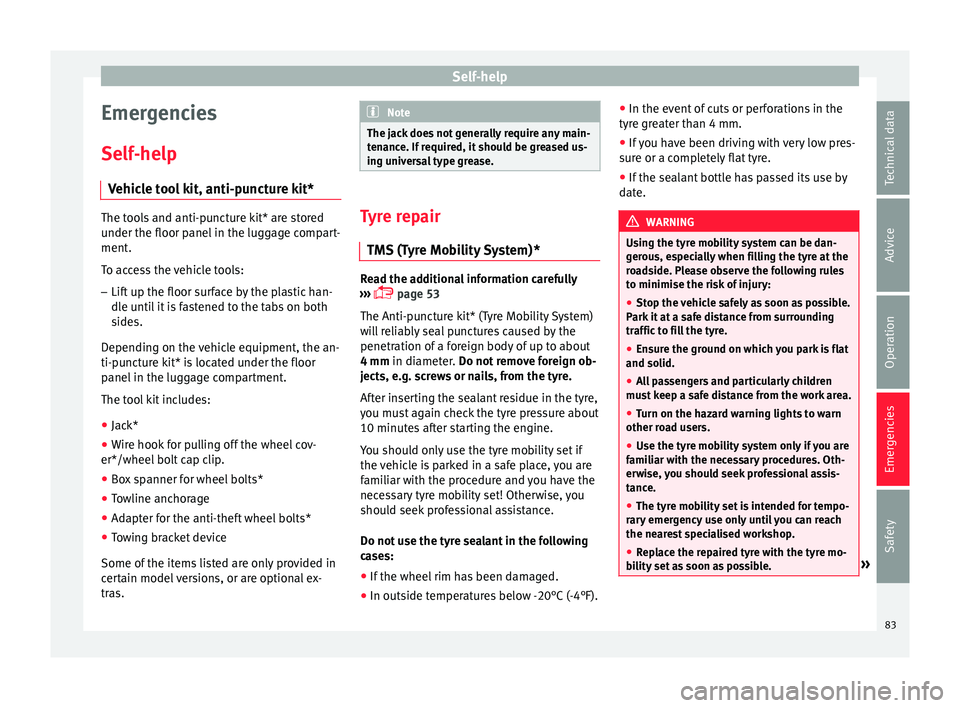
Self-help
Emergencies
Self -help
V
ehicle tool kit, anti-puncture kit* The tools and anti-puncture kit* are stored
u
nder the floor p
anel in the luggage compart-
ment.
To access the vehicle tools:
â Lift up the floor surface by the plastic han-
dl e u
ntil it is fastened to the tabs on both
sides.
Depending on the vehicle equipment, the an-
ti-puncture kit* is located under the floor
panel in the luggage compartment.
The tool kit includes:
â Jack*
â Wire hook for pulling off the wheel cov-
er*/wheel bo
lt cap clip.
â Box spanner for wheel bolts*
â Towline anchorage
â Adapter for the anti-theft wheel bolts*
â Towing bracket device
Some of the it
ems listed are only provided in
certain model versions, or are optional ex-
tras. Note
The jack does not generally require any main-
t en
ance. If required, it should be greased us-
ing universal type grease. Tyre repair
TM S
(Tyre Mobility System)* Read the additional information carefully
⺠âº
âº ï¨ page 53
The Anti-puncture kit* (Tyre Mobility System)
will reliably seal punctures caused by the
penetration of a foreign body of up to about
4 mm in diameter. Do not remove foreign ob-
jects, e.g. screws or nails, from the tyre.
After inserting the sealant residue in the tyre,
you must again check the tyre pressure about
10 minutes after starting the engine.
You should only use the tyre mobility set if
the vehicle is parked in a safe place, you are
familiar with the procedure and you have the
necessary tyre mobility set! Otherwise, you
should seek professional assistance.
Do not use the tyre sealant in the following
cases:
â If the wheel rim has been damaged.
â In outside temperatures below -20°C (-4°F). â
In the ev ent
of cuts or perforations in the
tyre greater than 4 mm.
â If you have been driving with very low pres-
sur
e or a completely flat tyre.
â If the sealant bottle has passed its use by
dat
e. WARNING
Using the tyre mobility system can be dan-
g er
ous, especially when filling the tyre at the
roadside. Please observe the following rules
to minimise the risk of injury:
â Stop the vehicle safely as soon as possible.
Park
it at a safe distance from surrounding
traffic to fill the tyre.
â Ensure the ground on which you park is flat
and solid.
â A
ll passengers and particularly children
mus
t keep a safe distance from the work area.
â Turn on the hazard warning lights to warn
other ro
ad users.
â Use the tyre mobility system only if you are
fami
liar with the necessary procedures. Oth-
erwise, you should seek professional assis-
tance.
â The tyre mobility set is intended for tempo-
rar
y emergency use only until you can reach
the nearest specialised workshop.
â Replace the repaired tyre with the tyre mo-
bi
lity set as soon as possible. » 83
Technical data
Advice
Operation
Emergencies
Safety
Page 88 of 328
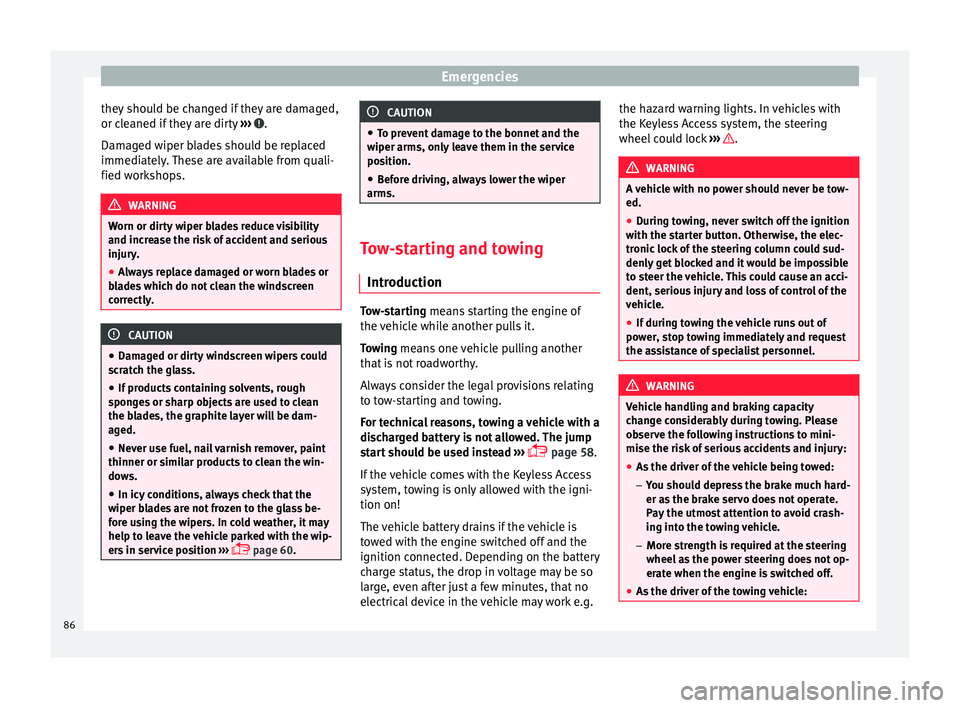
Emergencies
they should be changed if they are damaged,
or c l
eaned if they are dirty âºâºâº .
Dam ag
ed wiper blades should be replaced
immediately. These are available from quali-
fied workshops. WARNING
Worn or dirty wiper blades reduce visibility
and inc r
ease the risk of accident and serious
injury.
â Always replace damaged or worn blades or
bl
ades which do not clean the windscreen
correctly. CAUTION
â Dam ag
ed or dirty windscreen wipers could
scratch the glass.
â If products containing solvents, rough
spon
ges or sharp objects are used to clean
the blades, the graphite layer will be dam-
aged.
â Never use fuel, nail varnish remover, paint
thinner or simi
lar products to clean the win-
dows.
â In icy conditions, always check that the
wiper b
lades are not frozen to the glass be-
fore using the wipers. In cold weather, it may
help to leave the vehicle parked with the wip-
ers in service position âºâºâº
ï¨ page 60. CAUTION
â To pr
event damage to the bonnet and the
wiper arms, only leave them in the service
position.
â Before driving, always lower the wiper
arms. Tow-starting and towing
Intr oduction Tow-starting me
an
s starting the engine of
the vehicle while another pulls it.
Towing means one vehicle pulling another
that is not roadworthy.
Always consider the legal provisions relating
to tow-starting and towing.
For technical reasons, towing a vehicle with a
discharged battery is not allowed. The jump
start should be used instead âºâºâº
ï¨ page 58.
If the vehicle comes with the Keyless Access
system, towing is only allowed with the igni-
tion on!
The vehicle battery drains if the vehicle is
towed with the engine switched off and the
ignition connected. Depending on the battery
charge status, the drop in voltage may be so
large, even after just a few minutes, that no
electrical device in the vehicle may work e.g. the hazard warning lights. In vehicles with
the Keyl
ess Access system, the steering
wheel could lock âºâºâº .
WARNING
A vehicle with no power should never be tow-
ed.
â During towing, never switch off the ignition
w ith the s
tarter button. Otherwise, the elec-
tronic lock of the steering column could sud-
denly get blocked and it would be impossible
to steer the vehicle. This could cause an acci-
dent, serious injury and loss of control of the
vehicle.
â If during towing the vehicle runs out of
pow
er, stop towing immediately and request
the assistance of specialist personnel. WARNING
Vehicle handling and braking capacity
c h
ange considerably during towing. Please
observe the following instructions to mini-
mise the risk of serious accidents and injury:
â As the driver of the vehicle being towed:
â You shou
ld depress the brake much hard-
er as the brake servo does not operate.
Pay the utmost attention to avoid crash-
ing into the towing vehicle.
â More strength is required at the steering
wheel as the power steering does not op-
erate when the engine is switched off.
â As the driver of the towing vehicle: 86
Page 89 of 328
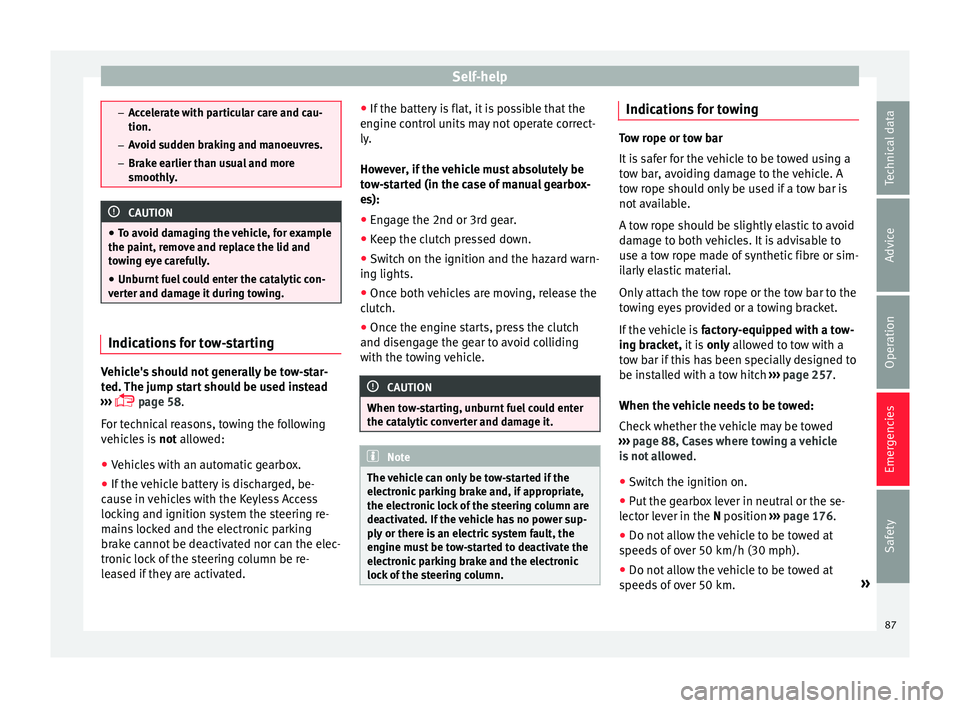
Self-help
â
Ac
celerate with particular care and cau-
tion.
â Avoid sudden braking and manoeuvres.
â Brake earlier than usual and more
smoothly. CAUTION
â To av
oid damaging the vehicle, for example
the paint, remove and replace the lid and
towing eye carefully.
â Unburnt fuel could enter the catalytic con-
ver
ter and damage it during towing. Indications for tow-starting
Vehicle's should not generally be tow-star-
t
ed.
The jump start should be used instead
âºâºâº ï¨ page 58.
For technical reasons, towing the following
vehicles is not allowed:
â Vehicles with an automatic gearbox.
â If the vehicle battery is discharged, be-
cau
se in vehicles with the Keyless Access
locking and ignition system the steering re-
mains locked and the electronic parking
brake cannot be deactivated nor can the elec-
tronic lock of the steering column be re-
leased if they are activated. â
If the b
attery is flat, it is possible that the
engine control units may not operate correct-
ly.
However, if the vehicle must absolutely be
tow-started (in the case of manual gearbox-
es):
â Engage the 2nd or 3rd gear.
â Keep the clutch pressed down.
â Switch on the ignition and the hazard warn-
ing lights.
â Onc
e both vehicles are moving, release the
clut
ch.
â Once the engine starts, press the clutch
and disen
gage the gear to avoid colliding
with the towing vehicle. CAUTION
When tow-starting, unburnt fuel could enter
the c at
alytic converter and damage it. Note
The vehicle can only be tow-started if the
el ectr
onic parking brake and, if appropriate,
the electronic lock of the steering column are
deactivated. If the vehicle has no power sup-
ply or there is an electric system fault, the
engine must be tow-started to deactivate the
electronic parking brake and the electronic
lock of the steering column. Indications for towing
Tow rope or tow bar
It
i
s safer for the vehicle to be towed using a
tow bar, avoiding damage to the vehicle. A
tow rope should only be used if a tow bar is
not available.
A tow rope should be slightly elastic to avoid
damage to both vehicles. It is advisable to
use a tow rope made of synthetic fibre or sim-
ilarly elastic material.
Only attach the tow rope or the tow bar to the
towing eyes provided or a towing bracket.
If the vehicle is factory-equipped with a tow-
ing bracket, it is only allowed to tow with a
tow bar if this has been specially designed to
be installed with a tow hitch âºâºâº
page 257.
When the vehicle needs to be towed:
Check whether the vehicle may be towed
âºâºâº page 88, Cases where towing a vehicle
is not allowed .
â Switch the ignition on.
â Put the gearbox lever in neutral or the se-
l ect
or lever in the N position âºâºâº
page 176.
â Do not allow the vehicle to be towed at
speed
s of over 50 km/h (30 mph).
â Do not allow the vehicle to be towed at
s peed
s of over 50 km. »
87
Technical data
Advice
Operation
Emergencies
Safety
Page 92 of 328
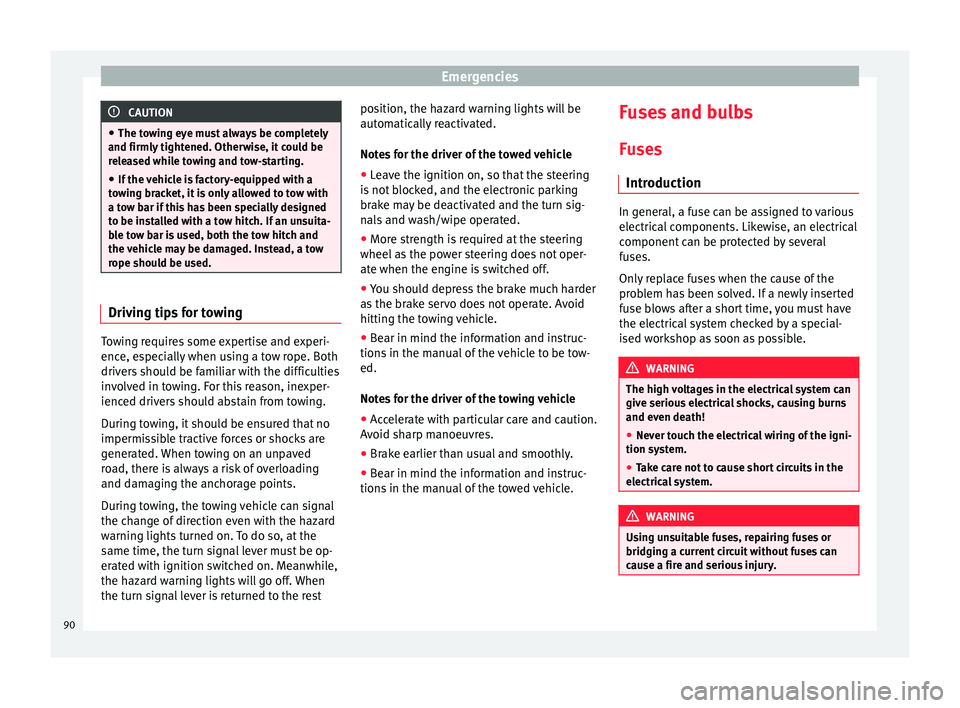
Emergencies
CAUTION
â The t o
wing eye must always be completely
and firmly tightened. Otherwise, it could be
released while towing and tow-starting.
â If the vehicle is factory-equipped with a
to
wing bracket, it is only allowed to tow with
a tow bar if this has been specially designed
to be installed with a tow hitch. If an unsuita-
ble tow bar is used, both the tow hitch and
the vehicle may be damaged. Instead, a tow
rope should be used. Driving tips for towing
Towing requires some expertise and experi-
enc
e, e
specially when using a tow rope. Both
drivers should be familiar with the difficulties
involved in towing. For this reason, inexper-
ienced drivers should abstain from towing.
During towing, it should be ensured that no
impermissible tractive forces or shocks are
generated. When towing on an unpaved
road, there is always a risk of overloading
and damaging the anchorage points.
During towing, the towing vehicle can signal
the change of direction even with the hazard
warning lights turned on. To do so, at the
same time, the turn signal lever must be op-
erated with ignition switched on. Meanwhile,
the hazard warning lights will go off. When
the turn signal lever is returned to the rest position, the hazard warning lights will be
autom
atically reactivated.
Notes for the driver of the towed vehicle â Leave the ignition on, so that the steering
is
not blocked, and the electronic parking
brake may be deactivated and the turn sig-
nals and wash/wipe operated.
â More strength is required at the steering
wheel a
s the power steering does not oper-
ate when the engine is switched off.
â You should depress the brake much harder
as
the brake servo does not operate. Avoid
hitting the towing vehicle.
â Bear in mind the information and instruc-
tions
in the manual of the vehicle to be tow-
ed.
Notes for the driver of the towing vehicle
â Accelerate with particular care and caution.
Av
oid sharp manoeuvres.
â Brake earlier than usual and smoothly.
â Bear in mind the information and instruc-
tions
in the manual of the towed vehicle. Fuses and bulbs
F u
ses
Introduction In general, a fuse can be assigned to various
el
ectric
al components. Likewise, an electrical
component can be protected by several
fuses.
Only replace fuses when the cause of the
problem has been solved. If a newly inserted
fuse blows after a short time, you must have
the electrical system checked by a special-
ised workshop as soon as possible. WARNING
The high voltages in the electrical system can
giv e seriou
s electrical shocks, causing burns
and even death!
â Never touch the electrical wiring of the igni-
tion sys
tem.
â Take care not to cause short circuits in the
electric
al system. WARNING
Using unsuitable fuses, repairing fuses or
bridgin g a c
urrent circuit without fuses can
cause a fire and serious injury. 90
Page 93 of 328
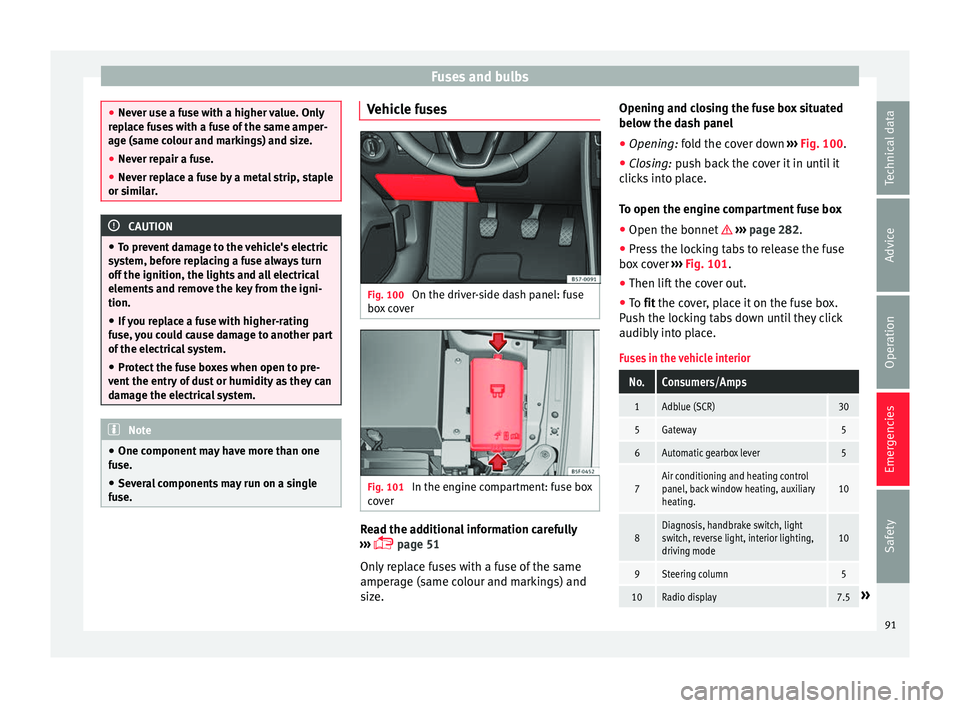
Fuses and bulbs
â
Nev er u
se a fuse with a higher value. Only
replace fuses with a fuse of the same amper-
age (same colour and markings) and size.
â Never repair a fuse.
â Never replace a fuse by a metal strip, staple
or simi
lar. CAUTION
â To pr
event damage to the vehicle's electric
system, before replacing a fuse always turn
off the ignition, the lights and all electrical
elements and remove the key from the igni-
tion.
â If you replace a fuse with higher-rating
fu
se, you could cause damage to another part
of the electrical system.
â Protect the fuse boxes when open to pre-
vent
the entry of dust or humidity as they can
damage the electrical system. Note
â One c omponent
may have more than one
fuse.
â Several components may run on a single
fu
se. Vehicle fuses
Fig. 100
On the driver-side dash panel: fuse
bo x
cover Fig. 101
In the engine compartment: fuse box
c o
ver Read the additional information carefully
⺠âº
âº ï¨ page 51
Only replace fuses with a fuse of the same
amperage (same colour and markings) and
size. Opening and closing the fuse box situated
below the d
ash panel
â Opening: fold the cover down âº
âºâº Fig. 100.
â Closing: push back the cover it in until it
c
licks into place.
To open the engine compartment fuse box
â Open the bonnet ï âºâº
⺠page 282.
â Press the locking tabs to release the fuse
box
cover âºâºâº Fig. 101.
â Then lift the cover out.
â To fit the cover, place it on the fuse box.
P
ush the locking tabs down until they click
audibly into place.
Fuses in the vehicle interior
No.Consumers/Amps
1Adblue (SCR)30
5Gateway5
6Automatic gearbox lever5
7Air conditioning and heating control
panel, back window heating, auxiliary
heating.10
8Diagnosis, handbrake switch, light
switch, reverse light, interior lighting,
driving mode10
9Steering column5
10Radio display7.5» 91
Technical data
Advice
Operation
Emergencies
Safety
Page 94 of 328
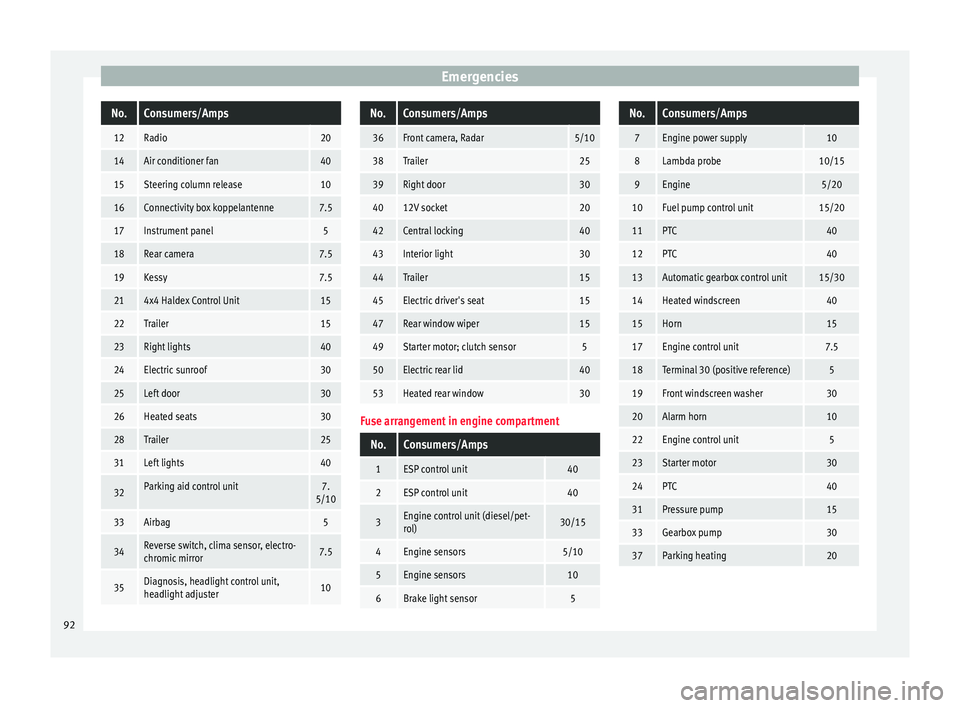
EmergenciesNo.Consumers/Amps
12Radio20
14Air conditioner fan40
15Steering column release10
16Connectivity box koppelantenne7.5
17Instrument panel5
18Rear camera7.5
19Kessy7.5
214x4 Haldex Control Unit15
22Trailer15
23Right lights40
24Electric sunroof30
25Left door30
26Heated seats30
28Trailer25
31Left lights40
32Parking aid control unit7.
5/10
33Airbag5
34Reverse switch, clima sensor, electro-
chromic mirror7.5
35Diagnosis, headlight control unit,
headlight adjuster10
No.Consumers/Amps
36Front camera, Radar5/10
38Trailer25
39Right door30
4012V socket20
42Central locking40
43Interior light30
44Trailer15
45Electric driver's seat15
47Rear window wiper15
49Starter motor; clutch sensor5
50Electric rear lid40
53Heated rear window30
Fuse arrangement in engine compartment
No.Consumers/Amps
1ESP control unit40
2ESP control unit40
3Engine control unit (diesel/pet-
rol)30/15
4Engine sensors5/10
5Engine sensors10
6Brake light sensor5
No.Consumers/Amps
7Engine power supply10
8Lambda probe10/15
9Engine5/20
10Fuel pump control unit15/20
11PTC40
12PTC40
13Automatic gearbox control unit15/30
14Heated windscreen40
15Horn15
17Engine control unit7.5
18Terminal 30 (positive reference)5
19Front windscreen washer30
20Alarm horn10
22Engine control unit5
23Starter motor30
24PTC40
31Pressure pump15
33Gearbox pump30
37Parking heating20 92
Page 95 of 328
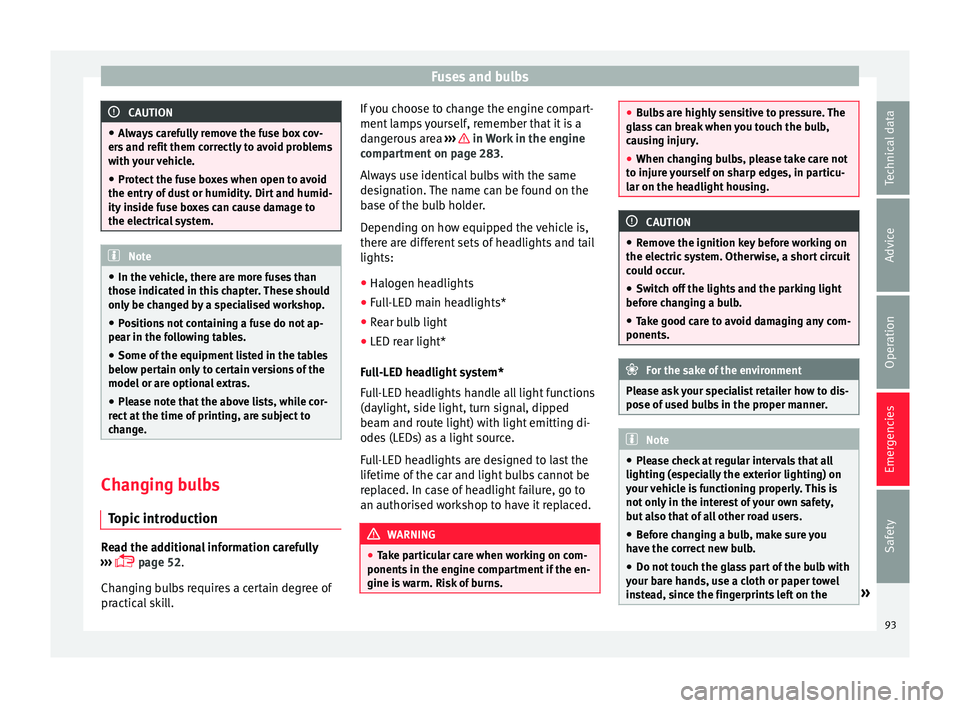
Fuses and bulbs
CAUTION
â Alw
ays carefully remove the fuse box cov-
ers and refit them correctly to avoid problems
with your vehicle.
â Protect the fuse boxes when open to avoid
the entry
of dust or humidity. Dirt and humid-
ity inside fuse boxes can cause damage to
the electrical system. Note
â In the v
ehicle, there are more fuses than
those indicated in this chapter. These should
only be changed by a specialised workshop.
â Positions not containing a fuse do not ap-
pear in the f
ollowing tables.
â Some of the equipment listed in the tables
below per
tain only to certain versions of the
model or are optional extras.
â Please note that the above lists, while cor-
rect
at the time of printing, are subject to
change. Changing bulbs
Topic
introduction Read the additional information carefully
⺠âº
âº ï¨ page 52.
Changing bulbs requires a certain degree of
practical skill. If you choose to change the engine compart-
ment l
amps yourself, remember that it is a
dangerous area âºâºâº in Work in the engine
c omp
artment on page 283.
Always use identical bulbs with the same
designation. The name can be found on the
base of the bulb holder.
Depending on how equipped the vehicle is,
there are different sets of headlights and tail
lights:
â Halogen headlights
â Full-LED main headlights*
â Rear bulb light
â LED rear light*
Fu
ll-LED headlight system*
Full-LED headlights handle all light functions
(daylight, side light, turn signal, dipped
beam and route light) with light emitting di-
odes (LEDs) as a light source.
Full-LED headlights are designed to last the
lifetime of the car and light bulbs cannot be
replaced. In case of headlight failure, go to
an authorised workshop to have it replaced. WARNING
â Tak
e particular care when working on com-
ponents in the engine compartment if the en-
gine is warm. Risk of burns. â
Bu
lbs are highly sensitive to pressure. The
glass can break when you touch the bulb,
causing injury.
â When changing bulbs, please take care not
to injur
e yourself on sharp edges, in particu-
lar on the headlight housing. CAUTION
â Remo
ve the ignition key before working on
the electric system. Otherwise, a short circuit
could occur.
â Switch off the lights and the parking light
befor
e changing a bulb.
â Take good care to avoid damaging any com-
ponents. For the sake of the environment
Please ask your specialist retailer how to dis-
po se of
used bulbs in the proper manner. Note
â Ple
ase check at regular intervals that all
lighting (especially the exterior lighting) on
your vehicle is functioning properly. This is
not only in the interest of your own safety,
but also that of all other road users.
â Before changing a bulb, make sure you
hav
e the correct new bulb.
â Do not touch the glass part of the bulb with
your b
are hands, use a cloth or paper towel
instead, since the fingerprints left on the » 93
Technical data
Advice
Operation
Emergencies
Safety
Page 96 of 328
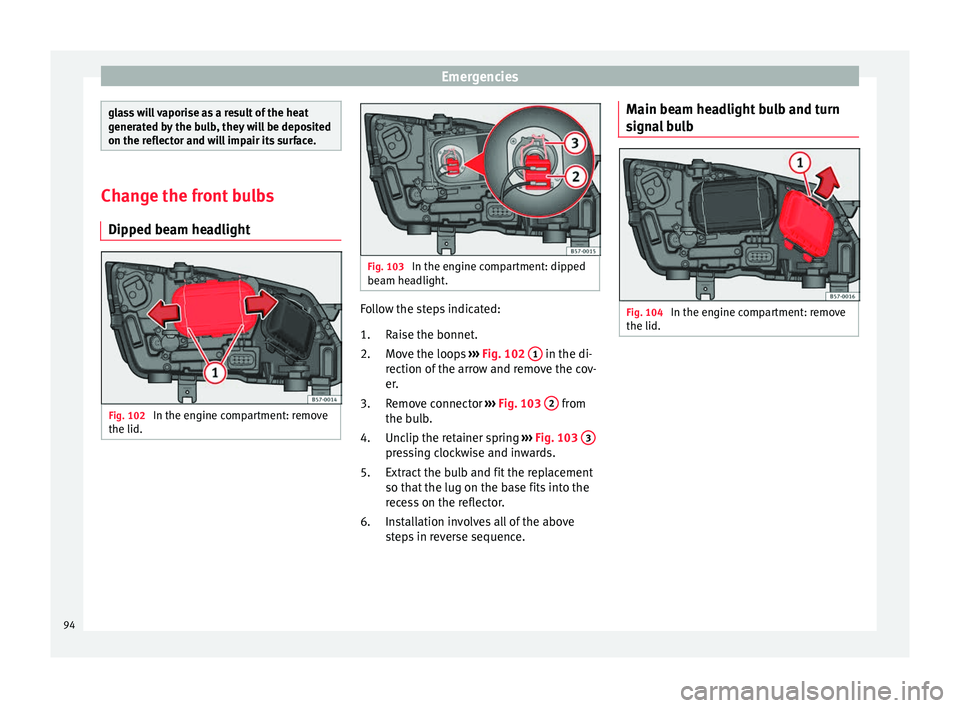
Emergencies
glass will vaporise as a result of the heat
g
ener
ated by the bulb, they will be deposited
on the reflector and will impair its surface. Change the front bulbs
Dip ped be
am headlightFig. 102
In the engine compartment: remove
the lid. Fig. 103
In the engine compartment: dipped
beam he
adlight. Follow the steps indicated:
Rai
se the bonnet.
Move the loops âºâºâº
Fig. 102 1 in the di-
r ection of
the arrow and remove the cov-
er.
Remove connector âºâºâº
Fig. 103 2 from
the b u
lb.
Unclip the retainer spring âºâºâº
Fig. 103 3 pressing clockwise and inwards.
Extr
act
the bulb and fit the replacement
so that the lug on the base fits into the
recess on the reflector.
Installation involves all of the above
steps in reverse sequence.
1.
2.
3.
4.
5.
6. Main beam headlight bulb and turn
sign
al bulb Fig. 104
In the engine compartment: remove
the lid. 94
Page 97 of 328
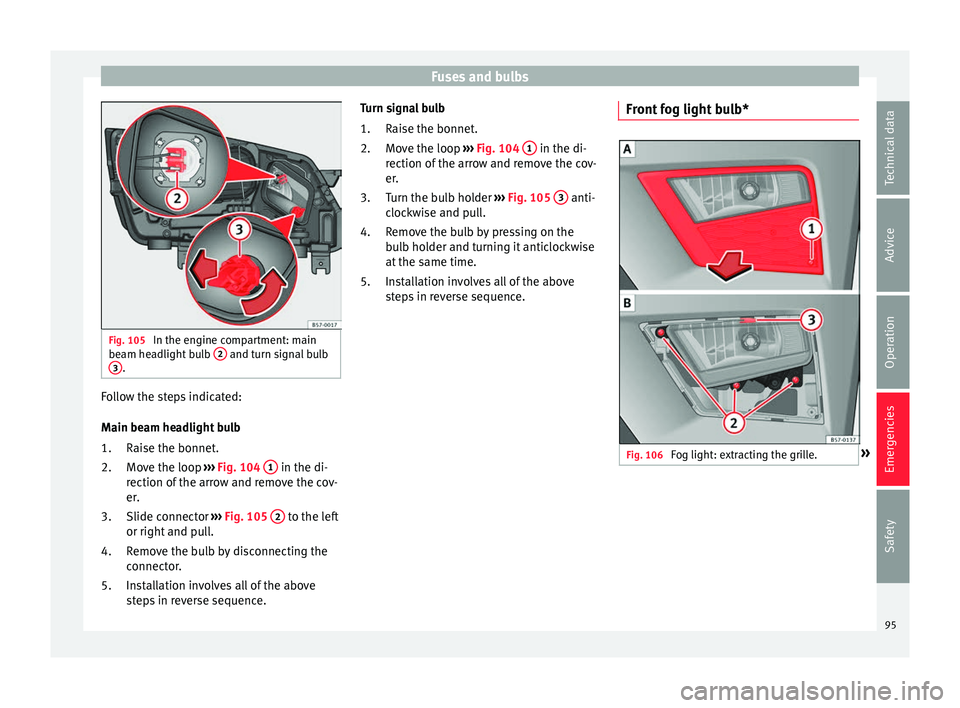
Fuses and bulbs
Fig. 105
In the engine compartment: main
be am he
adlight bulb 2 and turn signal bulb
3 .
Follow the steps indicated:
M
ain be
am headlight bulb
Raise the bonnet.
Move the loop âºâºâº Fig. 104 1 in the di-
r ection of
the arrow and remove the cov-
er.
Slide connector âºâºâº Fig. 105 2 to the left
or right and p
ull.
Remove the bulb by disconnecting the
connector.
Installation involves all of the above
steps in reverse sequence.
1.
2.
3.
4.
5. Turn signal bulb
Rai
se the bonnet.
Move the loop âºâºâº Fig. 104 1 in the di-
r ection of
the arrow and remove the cov-
er.
Turn the bulb holder âºâºâº Fig. 105 3 anti-
c loc
kwise and pull.
Remove the bulb by pressing on the
bulb holder and turning it anticlockwise
at the same time.
Installation involves all of the above
steps in reverse sequence.
1.
2.
3.
4.
5. Front fog light bulb* Fig. 106
Fog light: extracting the grille. » 95Technical data
Advice
Operation
Emergencies
Safety
Page 98 of 328
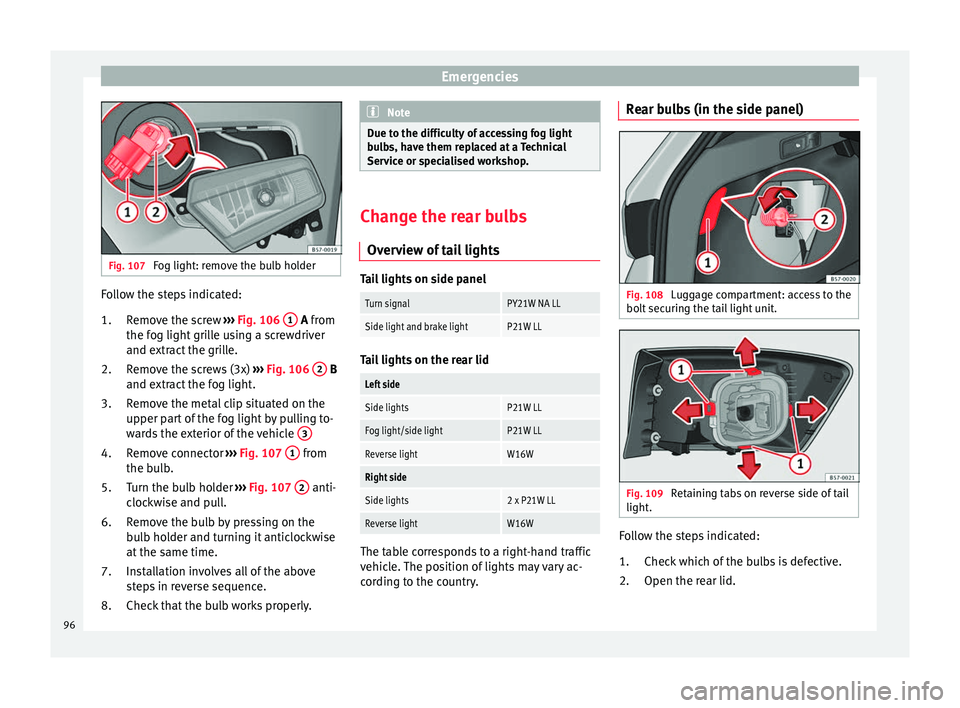
Emergencies
Fig. 107
Fog light: remove the bulb holder Follow the steps indicated:
Remo
ve the screw âºâºâº Fig. 106 1 A fr
om
the f
og light grille using a screwdriver
and extract the grille.
Remove the screws (3x) âºâºâº Fig. 106 2 B
and e xtr
act the fog light.
Remove the metal clip situated on the
upper part of the fog light by pulling to-
wards the exterior of the vehicle 3Remove connector
âºâº
âº
Fig. 107 1 from
the b u
lb.
Turn the bulb holder âºâºâº
Fig. 107 2 anti-
c loc
kwise and pull.
Remove the bulb by pressing on the
bulb holder and turning it anticlockwise
at the same time.
Installation involves all of the above
steps in reverse sequence.
Check that the bulb works properly.
1.
2.
3.
4.
5.
6.
7.
8. Note
Due to the difficulty of accessing fog light
b u
lbs, have them replaced at a Technical
Service or specialised workshop. Change the rear bulbs
Ov er
view of tail lights Tail lights on side panel
Turn signalPY21W NA LL
Side light and brake lightP21W LL
Tail lights on the rear lid
Left side
Side lightsP21W LL
Fog light/side lightP21W LL
Reverse lightW16W
Right side
Side lights2 x P21W LL
Reverse lightW16W
The table corresponds to a right-hand traffic
v
ehic
le. The position of lights may vary ac-
cording to the country. Rear bulbs (in the side panel)
Fig. 108
Luggage compartment: access to the
bo lt
securing the tail light unit. Fig. 109
Retaining tabs on reverse side of tail
light . Follow the steps indicated:
Chec k
which of the bulbs is defective.
Open the rear lid.
1.
2.
96